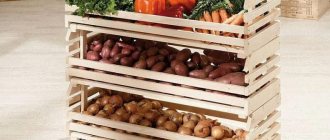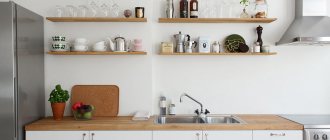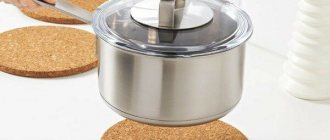Storing vegetables
Many people, by mistake and ignorance, store vegetables in the refrigerator or on the balcony, and then wonder why potatoes sprout quickly, carrots dry out, and onions rot. And everything is so banal! Vegetables, like other food products, require proper storage conditions. How to provide them in a small kitchen?
The easiest way out is to equip several kitchen drawers specifically for storing vegetables. Select baskets or containers to match the size of the furniture (there are now a wide variety of them in household and dishware stores). An alternative option would be wicker baskets made of wicker; in them, vegetables and fruits retain their freshness, beautiful appearance and good taste longer.
If stored properly, potatoes can last from 2 weeks to 2-3 months (under no circumstances should they be stored in the refrigerator), carrots will last for 3 weeks, and onions can be stored this way for up to 3-4 weeks.
Remember that the place where vegetables are stored should be well ventilated and located away from the stove, oven and radiators. Ideal - in a pantry or built-in kitchen cabinet.
Storing vegetables and fruits in the kitchen.
An example of how to store vegetables in the kitchen.
Storing vegetables in wicker baskets.
Features and difficulties of storing vegetables and fruits in the kitchen
Most often, when people bring fresh vegetables, they put them in different places in the refrigerator, believing that this is enough to preserve them. But this approach is wrong. Not all plant products should be refrigerated, since low temperatures not only destroy many useful substances in them, but also quickly lead the product to rotting processes. In addition, many types of food should not be adjacent. Therefore, for optimal preservation, it is recommended to purchase or make your own vegetable cabinet for the kitchen or loggia.
Under the wrong conditions, active processes of ripening, seed germination, and rotting of overripe pulp begin in fruits and root vegetables, which quickly renders them unusable and forces a person to buy new products. To ensure their safety, it is necessary to ensure the correct temperature conditions, ventilation or tightness, and correct location.
Note - Apples should always be stored separately from other vegetables and fruits, not only at room temperature, but also in the refrigerator. The close proximity of these fruits significantly accelerates the ripening processes of other plant foods, which shortens their shelf life.
Storage of bulk products
Boxes and bags of cereals are often the culprits behind clutter in kitchen cabinets. Firstly, they take up a lot of space, and secondly, they simply clutter up the space. To correct the situation, just pour the cereal, flour and sugar into glass jars or plastic containers.
It is very convenient to use vessels with special valves. Through them, midges, moths and moisture will not penetrate into bulk products. Often such valves are equipped with dispensers, with their help it is easy to pour cereal out of the vessel during cooking.
Storing cereals in the kitchen.
Storage of bulk products.
Storing cereals in glass jars.
Correct conditions for storing vegetables and fruits
Below you will find a table that presents the ideal storage times and conditions for popular vegetables and fruits in alphabetical order. But before we get into it, here are some general principles:
- Before storing any vegetables, it is recommended to remove the leaves, leaving only a couple of centimeters, which will prevent premature drying.
- Make sure the vegetable bag has multiple holes for ventilation (see table below - there are exceptions to this rule).
- Distribute the vegetables loosely throughout the refrigerator. The closer they are to each other, the faster they will begin to rot.
- Wash vegetables and fruits immediately before eating.
- Stone fruits (except cherries), tomatoes, melons, mangoes, avocados, apples and pears can be stored indoors, where they will continue to ripen.
- Sweet peppers, grapes, bananas, all citrus fruits and berries should only be stored in the refrigerator.
- Potatoes, onions, garlic and ginger root react poorly to high humidity in refrigerators, which is why they begin to rot and change their taste. They are best stored in wire and wicker baskets, wooden boxes and other ventilated containers at room temperature.
- It is recommended to store carrots and beets unwashed in a cool place. If it is a refrigerator, then the container for them should be airtight to protect them from moisture, which these root vegetables are afraid of.
Here are the best ways to store vegetables and fruits at home:
Also read: 30 ways to store spices in the kitchen
Cutlery
Storing spoons and forks in the same pile is not a good idea! Separate all the cutlery (for knives it is better to come up with a different storage place, not next to other items, so that they do not become dull and rust). Storage systems with separate cells look neat and stylish; you can buy ready-made options or make plywood partitions in a drawer yourself. It is advisable to cover their bottom with parchment paper or soft cloth, which will absorb excess moisture. It is better to put spoons and forks that are already dry and wiped with a towel in a drawer, since dried drops of water on the dishes will not look very attractive.
Storing cutlery in the kitchen.
Neat storage of cutlery.
An example of storing wooden spoons and spatulas.
An example of how to store spoons and forks.
Storing vegetables in the kitchen
A diligent housewife always has food supplies in the kitchen.
Vegetables and fruits are no exception. Some of them are stored in the refrigerator freezer or freezer in the form of blanks, some are rolled up in compotes and various preserves. But still, most of it is needed fresh for cooking. And this requires well-thought-out storage of vegetables in the kitchen. There is a certain set of rules under which fresh vegetables and fruits are stored longer. Here are some of them:
• Vegetables and fruits should not be stored together. During storage, fruits emit ethylene, a gas that accelerates fruit ripening and, as a result, rapid spoilage. You've probably heard advice on how to speed up the ripening of avocados or tomatoes - you just need to leave them overnight with bananas or apples nearby. This is how ethylene works.
• It is better to soak greens before storing – humidity helps maintain freshness. But it is better to store vegetables and fruits unwashed and dry.
• Store vegetables in the kitchen in a cool, dark place with good ventilation. Best in perforated boxes and paper bags. Good air circulation helps not retain moisture, vegetables will not rot or rot.
• All vegetables can be divided into two groups: above-ground and “underground” (root vegetables). Ground vegetables are best stored in the refrigerator, but root vegetables need to be stored in a cool and dark place in cabinets and cabinets in the kitchen.
Since many fruits and vegetables can be stored at room temperature, the question arises: what is the best way to store them? Ideally, containers and boxes for vegetables should have ventilated walls and not take up much space.
5 useful recommendations from the designer
- A deep roll-out box with high sides is best for storing fruits and vegetables. We can organize such a box especially for you, using special fittings - rails and sides. The capacity of such a box will increase significantly
- Another practical storage option is stainless steel roll-out metal grids.
- Make sure there is good ventilation. Lattice facades or mesh inserts in a frame made of MDF, solid wood or metal do an excellent job of this task.
- A mandatory element of a vegetable drawer is dividers. In custom-made kitchens, if desired, you can immediately order a vegetable drawer with wooden sides and partitions. In modern kitchens, it is much more convenient to use plastic or metal dividers and organizers, which are offered by all major hardware manufacturers. You can find them in different price categories. It's practical. If desired, you can change the internal configuration of the box in one motion. For example, add an extra compartment for potatoes, onions or carrots by simply moving the divider.
- Wicker baskets made of wicker with wooden or plastic sides are very good for storing vegetables and fruits in the kitchen. They slide along the guides and are as convenient to use as a drawer. In a basket made of natural material, products feel much better. But wicker accessories are an addition, first of all, for kitchens in the style of modern classics, country or Provence. However, baskets with a laconic rectangular design will fit well into the interior of a modern-style kitchen.
A properly selected vegetable storage system will not only allow you to optimize your kitchen space, but will also reduce food losses during storage. When choosing such furniture, you should consider what vegetables and fruits you usually purchase and store, and we, in turn, will help you select and implement any type of storage.
Pots, pans, stewpans
A good housewife always has a lot of kitchen utensils, including pots, pans, and stewpans. By the way, we noticed that many of these items are equipped with a hole at the end of the handle, and for a reason. It is needed to hang stewpans on hooks; in Europe this is a fairly common option for storing dishes.
Another question is where to install those same hooks? There are several options: on rails near the work area, on the wall near the stove or sink. You can also hang a decorative metal mesh on the wall and equip it with hooks. This storage option looks at least original and is very practical. It allows you to unload kitchen cabinets and instantly restore order in the kitchen. Plus, when preparing a particular dish, you won’t have to look for the right utensils for a long time.
Stylish storage of saucepans in the kitchen.
An example of how to store frying pans and saucepans in the kitchen.
Stylish storage in the kitchen.
Storage areas for vegetables
The kitchen is a place where there is a corner for everything. Vegetables and fruits are kept in the refrigerator or in cabinets, marinades are in pantries. A thrifty housewife always has something to prepare a fresh salad from. Where to store vegetables so that they delight people with their beneficial properties.
- Cucumbers, zucchini, peppers, eggplants, cabbage, celery and herbs are great in the refrigerator. The bottom shelf with carriages is suitable for vegetables.
- The good thing about the refrigerator is that you can set the required temperature in it. Also in the unit, cut vegetables are perfectly stored in airtight containers.
- You can install a heating cabinet on the balcony. It is quite bulky, so it will take up a lot of space in the kitchen.
- In Khrushchev-era apartments, there is a special niche under the window that serves as a refrigerator in the winter.
- In large rooms there are special storage rooms where marinades are stored. There can be a cabinet or cabinet for storing vegetables. Unopened products last longer. Almost all vegetables do not like sunlight once they are ripe.
Vegetables can be stored in drawers and under the sink, on separate racks and in bags. The main requirements remain for temperature and humidity. Every housewife arranges her kitchen so that it is convenient for her to cook.
,You can store peeled walnuts at home for a long time in an airtight container even if, Meat is classified as a perishable product, and it can be stored for up to two years. Plants are designed to decorate human life, but they themselves are short-lived. How to make chrysanthemums
Walls to the rescue
The size of the kitchen does not always allow it to accommodate a full number of cabinets for storing kitchen utensils. What to do in this case? Don't despair and use the walls! Even one small one is enough for these purposes. You can install hooks, rails, narrow shelves on it, install a plywood board with holes, and magnetic holders. Pots, stewpans, spices, cereals, ladles, spatulas, skimmers and other kitchen utensils will fit perfectly here.
Storing kitchen utensils on the wall.
Convenient storage system in the kitchen.
Stylish storage of pots in the kitchen.
Features of storing vegetables
Interesting ideas come to mind for the owners of small apartments where there is no separate space for a storage room or warehouse. Plastic containers, canvas bags and baskets are used to store vegetables. Marinades find a place in built-in cabinets and on shelves in pantries. Each product requires special conditions that must be created in the kitchen.
Potatoes, carrots, cabbage
Tubers do not require cold and tolerate room temperature well. Potatoes can be placed in a vegetable storage box and covered to keep out the sun's rays. The temperature in the room for long-term keeping of tubers should not exceed 15 degrees. In such conditions, potatoes will last 3-4 months.
For storage in the kitchen, you need to bring a small amount of vegetables, since at room temperature the tubers do not spoil for 2 weeks, and then they lose their shape, dry out and rot. In order for the potatoes to last longer, they must be thoroughly dried after assembly.
Carrot . A vegetable storage cabinet will not work for carrots. It quickly withers and begins to deteriorate. It is possible to extend the shelf life by placing root vegetables in the refrigerator. Carrots are placed in a bag. It is necessary to create the necessary humidity for it to prevent drying out. Too much water causes carrots to rot. Washed fruits do not dry out, but do not last long. Carrots can last about three weeks in a bag in the refrigerator.
Cabbage . Regardless of the type of cabbage, its place is only in the refrigerator, due to its love for low temperatures. In the room, the top leaves begin to wither and the middle begins to rot. At a temperature of +3-+6, the heads of cabbage will last up to 2 weeks. You can increase the shelf life. If you store cabbage at a temperature of plus/minus one degree with a humidity of 90-95 percent, it will last for about a month. You can use a balcony and vegetable containers to keep the heads of cabbage. They will remain in a glassed room with a temperature from -1 to +5 all winter.
Beet
Juicy bright beets love the cold and are not afraid of it. To prevent the fruits from disappearing, you need to place them in food containers. They create sufficient humidity, which extends the shelf life by several weeks. Beets can withstand up to plus one degree, so they sit well on the balcony until winter.
Onions and garlic
A vegetable storage cabinet is perfect for onions. It tolerates temperatures well up to 20 degrees. The absence of sunlight and low humidity in the cabinet are ideal conditions for preserving the heads. Before installation, you must ensure the quality of the product. Spoiled and rotten fruits can be cleaned and placed in the refrigerator to be used first.
Onion storage ideas:
- wicker baskets,
- open and closed boxes,
- mesh bags,
- onion braids,
- nylon stockings.
Vegetable storage containers with small holes are also suitable for storing onions in the kitchen. A small amount of product can be placed in the refrigerator. Onions are not afraid of low temperatures, but do not like high humidity, from which they must be protected.
Garlic . Fans of spicy food do not sit down at the table without a head of aromatic garlic. Even though it is very hard, storage can be problematic. After assembly, the garlic heads need to be thoroughly dried. You can hang braided braids in a vegetable storage cabinet. If the heads begin to break into cloves, they should be moved to a cool place. Garlic can sit in the refrigerator for a long time. The main problem with the vegetable is molding or drying out of the cloves, so moisture control is needed.
Tomatoes
The most delicious and most capricious representatives of vegetables are tomatoes. In the refrigerator, they lose their aroma and sweetness, turning into tasteless grass. If you use a vegetable storage container with holes, you can leave the tomatoes at room temperature. It will not be possible to sustain a large harvest of ripe fruits all winter. Tomatoes should be eaten according to their degree of ripeness. Oddly enough, tomatoes tolerate storing vegetables in the kitchen very well. It must be taken into account that tomatoes, when ripe, release ethylene, which promotes the rapid ripening of other vegetables.
Cucumber, eggplant, zucchini, bell pepper
The category of perishable foods includes cucumbers, zucchini and eggplants. They are quite watery, so they begin to rot quickly. A vegetable storage cabinet is not suitable for fresh cucumbers. The best option for them is a refrigerator carriage. Watery vegetables can last no more than a week, so they must be eaten or processed.
Storing vegetables in the kitchen in the refrigerator will outlive bell peppers. It cannot be in a plastic bag. A vegetable storage container is ideal for storing green bell peppers for 3 weeks. Airtight containers must be used. Red and yellow peppers last for about two weeks. If the vegetable is not very dirty, then it does not need to be washed. Excessive moisture promotes rapid rotting.
Celery and green onions
The juicy vegetable does not tolerate heat, so it must be placed in the refrigerator. Celery will last up to two weeks on the bottom shelf and wrapped in foil. But you don’t need to test its strength for so long; it’s better to cook something within a few days. Succulent herbaceous plants cannot be left at room temperature, as they quickly wither. High humidity leads to rotting, which is why it is recommended to wrap celery in foil.
Green onions . Even though onion feathers are very delicate, they can last up to two weeks in the cold. Shelf life increases if you wrap the greens in foil or paper towel. When humidity is high, the feathers begin to rot. To prevent this from happening, you need to protect the vegetable from water. Onions can last a week at room temperature if the roots are immersed in water. In this case, the feathers should not touch the liquid.
Order in the little things
Order comes from little things, don’t lose sight of them. Stack the bowls one inside the other, designate a place for plastic containers (and their lids!). Store confectionery supplies in one place; allocate a separate cabinet or shelf for them. A wicker box is perfect for storing baking dishes. Once you determine a place for each item, order will take root in your kitchen.
Storing plastic containers in the kitchen.
Storing baking dishes.
How to store vegetables in an apartment without a balcony
The balcony or loggia that is in the apartment will, of course, be a place to store the gifts of nature. But, if they are not there, or it is not possible to equip a balcony for vegetable storage, then let’s look at options for storing vegetables in an apartment without a balcony. Regardless of where you store your vegetables, follow the basic rules that will allow you to enjoy the taste of the products for as long as possible.
- We go through the supplies that you brought into the house, getting rid of those that are moldy or rotten. Overripe or bruised fruits are set aside for consumption in the near future.
- Never wash vegetables.
- To store large quantities of vegetables, we prepare boxes, nets or bags so that there is always air access to the root vegetables.
Advice:
periodically look through and sort through your stored vegetables and get rid of rotten and moldy ones.
The presence of a pantry in the apartment will be an excellent storage only for certain types of vegetables. The fact is that many root vegetables will perfectly retain their appearance and taste at room temperature. Therefore, by building something like shelving in the pantry or installing drawers there, we get an excellent vegetable storage. Let's look at the features of storing basic vegetables, for example, necessary for borscht:
- potato. This root vegetable is contraindicated in both high humidity and light, as well as high temperatures. Therefore, we choose a place for potatoes that is dark and cool, with a temperature no higher than 10 degrees. If the pantry is warm enough, place a box, vented container, or wicker basket of potatoes in the pantry near the door or, if space allows, in the hallway near the front door. The main thing is to stay away from radiators and heaters, otherwise the potatoes will begin to sprout or rot.
- beet. The potato's friend requires the same attention. So feel free to keep them together.
- onion. This comrade loves warmth and does not tolerate humidity. You can store only a few onions in the refrigerator for the first time; put the rest of the onions in a plastic net, box or wicker basket.
- cabbage. The top leaves of cabbage perfectly retain the freshness of the vegetable, preventing it from drying out. If the shelf life is not intended to be long (one or two months), then wrap each cabbage in paper, but not printing paper. And, if you have such an amount of cabbage that it will last you for six months, then hang each vegetable by a stalk in the pantry and the cabbage will be perfectly preserved. This applies to both white and red cabbage.
- carrot. Carrots do not like moisture and heat. To avoid lethargy and rotting, place the carrots in a box or basket and place them in the pantry by the door. You can also store carrots in the refrigerator in the vegetable compartment, but then we wrap each root vegetable in paper and periodically check that the paper does not become wet. If the paper is wet, wipe the compartment dry, dry all the carrots and wrap the root vegetables in dry paper.
Advice
When storing carrots in boxes, to maintain freshness as long as possible, place a few horseradish roots between the root vegetables.











